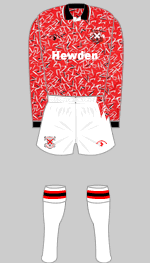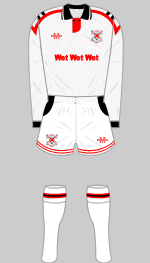

Clydebank
Formed 1965. Reconstituted as Airdrie United 2002.
Elected to Scottish Division Two 1966. Replaced by Airdrie United in 2002
Kit History
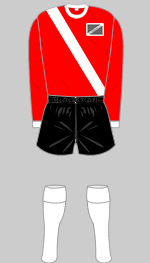
1965-1967 f l
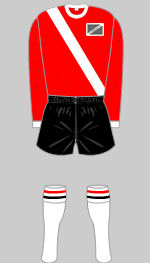
1967-1968 f
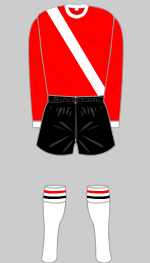
1968-1969 f
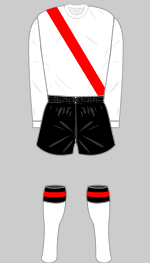
1969-1970 f

1970-Aug 71 f m
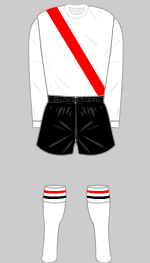
Sept 1971 f n

Sept 71-1972 n
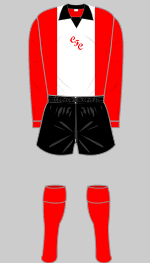
1972-1974 a f
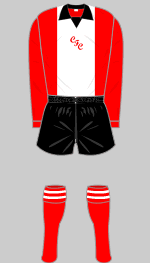
1974-1975 a f
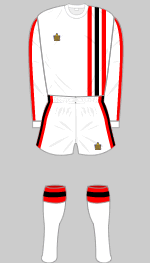
1975-1977 a f k n
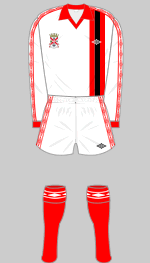
1977-1979 b d e f
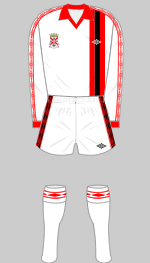
1979-1980 n
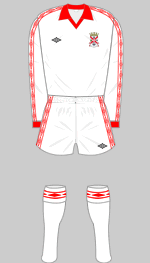
1980-1983 b e g h n
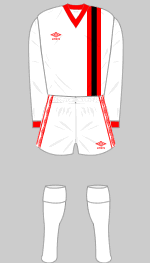
1983-1985 g
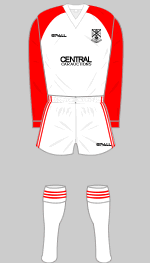
1985-1986 d e n
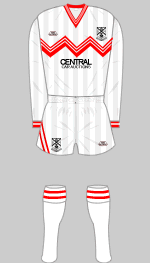
1986-1987 e n
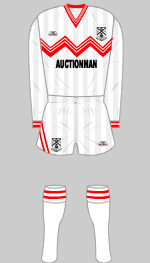
1987-1989 b n
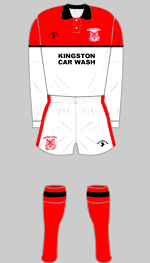
1989-1990 a e
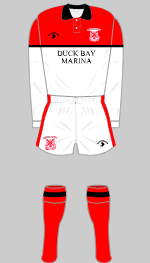
1990-1991 e j
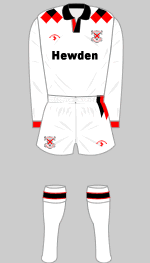
1992-1993 e n
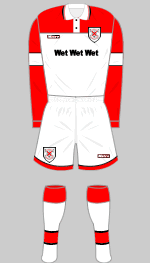
1995-1997 e i n
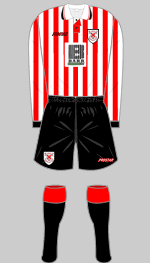
1997-1998 i j
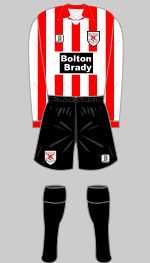
1998-1999 i
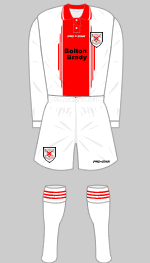
1999-2000 e i
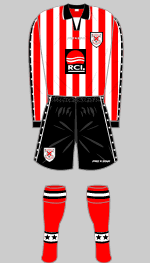
2000-Aug2001 c e i
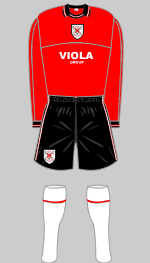
Sept 2001 e
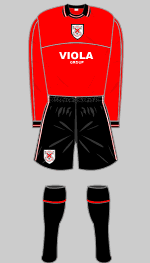
Oct 2001-2002 e
Background
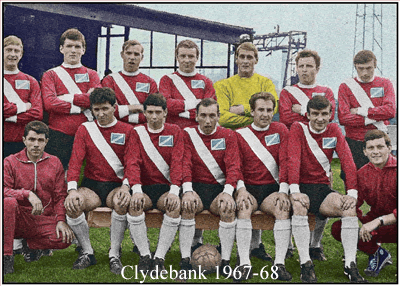 In 1964 the owners of East
Stirlingshire FC, the Steedman brothers, negotiated a merger
with Clydebank Junior FC (formed in 1899) and moved the club from its
Falkirk base to Clydebank's Kilbowie ground. This club played as ES
Clydebank during 1964-65 but at the end of the season a legal challenge
forced a return to Falkirk and they resumed playing as East Stirlingshire
FC. The Steedman brothers chose to remain with Clydebank and established
them as a senior
In 1964 the owners of East
Stirlingshire FC, the Steedman brothers, negotiated a merger
with Clydebank Junior FC (formed in 1899) and moved the club from its
Falkirk base to Clydebank's Kilbowie ground. This club played as ES
Clydebank during 1964-65 but at the end of the season a legal challenge
forced a return to Falkirk and they resumed playing as East Stirlingshire
FC. The Steedman brothers chose to remain with Clydebank and established
them as a senior 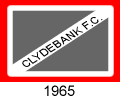 club. After a season competing in the Combined Reserve League they were elected to the Scottish Football League.
club. After a season competing in the Combined Reserve League they were elected to the Scottish Football League.
The club enjoyed some success: promotions in 1976 and 1977 took them briefly into the Premier Division for one season.
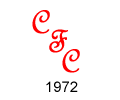 In 1977 the Bankies adopted the coat of arms of Clydebank District Council: the cog wheel represents the towns association with industry, the galleon
In 1977 the Bankies adopted the coat of arms of Clydebank District Council: the cog wheel represents the towns association with industry, the galleon 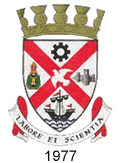 symbolises shipbuilding while the castle represents the Antonine Wall, part of which passes through the district. The figure in the fourth quarter is that of St Patrick who is believed to have born nearby: the red saltire is probably the cross of St Patrick.
symbolises shipbuilding while the castle represents the Antonine Wall, part of which passes through the district. The figure in the fourth quarter is that of St Patrick who is believed to have born nearby: the red saltire is probably the cross of St Patrick.
The Bankies returned to the top level in 1985 following another league reorganisation. The badge had evolved slightly, losing the 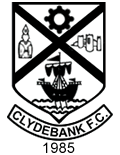 crown of thistles and replacing the Latin motto with the club's name.
Clydebank spent two seasons competing against the top clubs before being relegated.
crown of thistles and replacing the Latin motto with the club's name.
Clydebank spent two seasons competing against the top clubs before being relegated.
In 1989 the club introduced what became their definitive crest, with "Clydebank FC" moved to the top and the Latin motto (which translates as "By Work and Knowledge") restored underneath. This 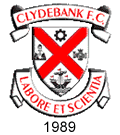 design was updated slightly in 1995 when it was placed on a larger shield.
design was updated slightly in 1995 when it was placed on a larger shield.
In 1990 they reached the semi-final of the Scottish FA Cup. Their most
famous player, Davie Cooper began his career at Clydebank, went on to
play for Rangers and Motherwell and became a regular in the Scotland
side during the 1980s. Cooper returned to Clydebank in 1993 as a player
and assistant coach but in March 1995, at the age 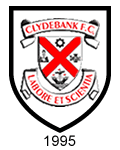 of 39, he died of
a brain haemorrhage, a tragedy that shook Scottish football.
of 39, he died of
a brain haemorrhage, a tragedy that shook Scottish football.
Kilbowie became one of the first all-seated stadiums in the UK, albeit because wooden benches were installed on the terraces. In 1996 the Steedmans sold the ground for development an event that marked the beginning of terminal decline. The Bankies spent six years playing their home games at Dumbarton's Boghead and later Morton's Cappielow Park while their support dwindled. Owing to a supporters' boycott, a mere 29 people watched them play their first match in Greenock in August 1999. Various schemes were hatched to relocate the club to Galashiels, Carlisle and even Dublin but these came to nothing.
In 2002 Airdrieonians were declared bankrupt and resigned from the Scottish League. A new club, Airdrie United was formed but their attempt to gain election to the league was rebuffed. Airdrie's owners immediately turned their attention to homeless Clydebank, now in administration and on the verge of extinction. With the support of the Scottish League management committee, Airdrie United bought out Clydebank, moved the club to Airdrie and took over their place in the Scottish Second Division (third tier). Technically Airdrie United are the continuation of Clydebank but most commentators and fans regard this as the moment when Clydebank ceased to exist.
Considerable bitterness was aroused by these machinations but a group of supporters formed the United Clydebank Supporters' trust (UCS) and succesfully reformed Clydebank as a junior club having raised a six-figure sum in a matter of a few days. They joined the Central District League of the Scottish Junior FA and have rapidly established themeslves as on the of the strongest sides competing at this level.
Sources
- (a) Official Clydebank JFC website
- (b) jumpers4goalposts
- (c) BBC Sport
- (d) e-bay
- (e) SNSpix
- (f) Alick Milne
- (g) Ralph Pomeroy
- (h) Alasdair Thorburn
- (i) Donald Gellatly
- (j) Keith Ellis
- (k) Mike Reid
- (l) Flickr
- (m) @smernicki
- (n) Ian McConnel
Crests are the property of United Clydebank Supporters.
